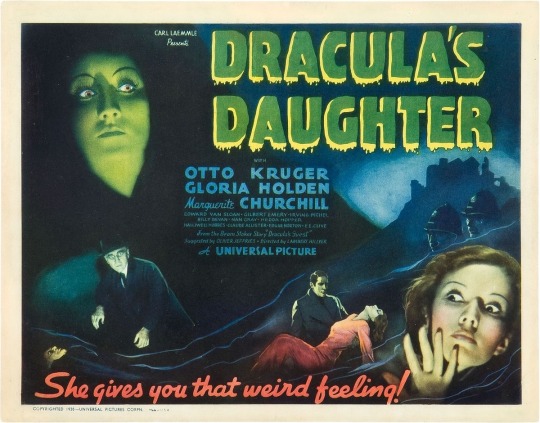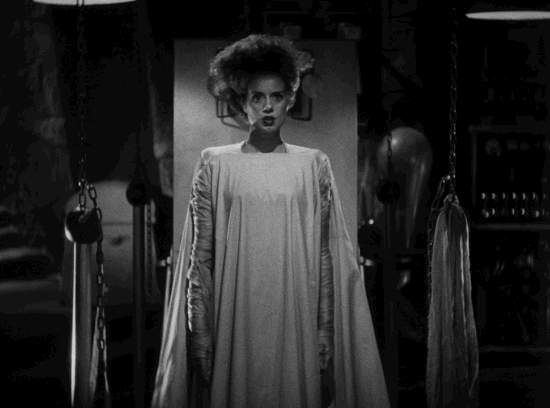Text

Alien (1979)
Sigourney Weaver (Ellen Ripley) with a prop face hugger next to Roger Dicken (Special Effects Artist)
Fun Fact: The iconic title that opens the movie was designed by legendary Oscar-winning designer Saul Bass, famous for designing the opening credits and posters for classics like Vertigo (1958), Anatomy Of A Murder (1959) and The Shining (1980). The original idea was to have the title made up of flesh and bone but, when Ridley Scott came on board as director, he thought this was too graphic, and Bass was brought in. Bass remains uncredited in the movie, though.

6 notes
·
View notes
Text


Dracula’s Daughter (1936)
Review: Dracula’s Daughter was a very intriguing watch, a beautiful cast of actors and actresses. Countess Zaleska played by (Gloria Holdon) gave a very hypnotic and gothic performance in this movie. She lures you in with her rather reserved personality. It’s safe to say she steals the spotlight and rightfully so. Moving onto the scenery and cast I have to say the scenery is rather limited as most of the movie is shot indoors and in offices and studios, there isn’t much to look at artistry wise with the set design of the movie. But what lacks in the scenery is made up in the beautiful and elegant dresses that our main character Countess Zaleska wears throughout the movie. Let’s not forget the wonderful performance of Doctor Garth played by (Otto Kruger) he gives an amazing on stage presence and plays his character very well along with Janet played by (Marguerite Churchill) the two seemed to have an instant chemistry as soon as you lay eyes on them and their scenes together proved this.
My Summary: The movie starts with a slight comedic and not so serious tone, you get a feel for certain characters and their complicated but obvious attraction to each other especially with Doctor Otto and Janet. Soon the movies tone seems to shift into a more serious and interesting style as Countess Marya Zaleska appears and finds herself trying to rid her body of the disease known as vampirism. She finds herself enamored with the doctor, hoping he could cure her need for human blood. The Countess goes on to lure women and men with the help of her servant Sandor played by (Irving Pichel). The vampire finds herself unleashing her secret with the deaths of her victims, Doctor Otto is suspicious as one of her victims relayed enough information on who had attacked her, giving away Zaleskas whereabouts before the victim died. The doctor finds The Countess and persuades her to tell the truth. Towards the end of the movie we find Countess Zaleska has kidnapped Janet where soon Doctor Otto finds them and pleads for the Countess to take his life instead of Janet’s. Before Countess Zaleska is able to transform the man she is shot in the heart by her servant Sandor and is declared dead. Doctor Otto and Janet share a moment with each other as they soon realize that they care and love each other more then they had let on earlier. The movie ends with a shot of a dead Countess Marya Zaleska with the last words of Van Helsing. “She was beautiful when she died, a hundred years ago.”
Queer Thoughts: Moving on I would like to discuss some things I noticed while watching Dracula’s Daughter. The coded Queerness between Countess Zaleska, Janet and a character with little screen time Ms. Lili played by (Nan Grey). There are two small scenes in which these three women have interesting encounters with one another. In one scene the Countess lures Ms. Lili into her private studios, requesting for Lili to pose for a new painting the Countess wants to paint. You watch as the girl slips her blouse down a bit, the Countess gazes upon the woman almost longing for her. It holds a tone of yearning and to add to this the way the camera captures the longing emotions of the Countess. The last scene is towards the ending where Zaleska has captured Janet in her fathers castle. Janet lays unconsciously, Countess Zaleska leans in gently and the camera captures a very tender moment we’re it seems as though the Countess is leaning down to kiss a sleeping Janet. It’s very evident what the movie was going for with the queer representation even though it was meant to portray Queer people as impure, perverted and monstrous it most certainly failed and would most likely fail with the generation of this time as the characters displayed nothing but human emotion such as loneliness and the need to be loved.

3 notes
·
View notes
Text


The Bride of Frankenstein (1935):
Review: A wonderful sequel to the (1931) Frankenstein, the movie draws you in with its gorgeous and compelling scenery and cinematic visuals.
Watching from beginning to end you get to see Frankensteins monsters developing need for human connection, wanting more then anything to connect with another living being as all he wants to do is communicate with those around him. The plot of the story was bittersweet, the one person who was most literally made for him feared him just as those around him.
On another note I found the costume for the bride to be one of my favorite monster costumes of all time. The hair, the facial expression all of it was well done. The special effects and editing that was done for this movie were ahead of its time in my honest opinion the miniature sized people that Doctor Septimus created were so cool to look at and watch. I will say the movie felt as though it had ended abruptly and it made me want to watch even more which I intend to do so very soon!.

3 notes
·
View notes